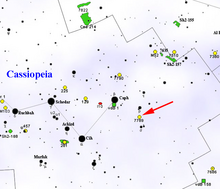| NGC 7789 | |
|---|---|
 NGC 7789 taken with an amateur telescope Credit: Hewholooks | |
| Observation data (J2000.0 epoch) | |
| Right ascension | 23h 57m 24s [1] |
| Declination | +56° 42′ 30″ [1] |
| Distance | 7.6 kly (2,337 [2]) |
| Apparent magnitude (V) | 6.7 |
| Apparent dimensions (V) | 16′ [2] |
| Physical characteristics | |
| Mass | 6,620.4 ± 762.5 [3] M☉ |
| Estimated age | 1.7 GYr [2] |
| Other designations | Caroline's Rose, [4] White Rose Cluster, Cr 460, Mel 245 |
| Associations | |
| Constellation | Cassiopeia |
NGC 7789 (also known as Caroline's Rose, [4] Caroline's Haystack, [5] or the White Rose Cluster) is an open cluster in Cassiopeia that was discovered by Caroline Herschel in 1783. Her brother William Herschel included it in his catalog as H VI.30. This cluster is also known as the "White Rose" Cluster or "Caroline's Rose" Cluster because when seen visually, the loops of stars and dark lanes look like the swirling pattern of rose petals as seen from above.

- ^ a b Xin, Y; Deng, L (2005). "Blue Stragglers in Galactic Open Clusters and Integrated Spectral Energy Distributions". The Astrophysical Journal. 619 (2): 824–838. arXiv: astro-ph/0410325. Bibcode: 2005ApJ...619..824X. doi: 10.1086/426681. S2CID 2087723.
- ^ a b c Kharchenko, N. V; Piskunov, A. E; Röser, S; Schilbach, E; Scholz, R.-D (2005). "Astrophysical parameters of Galactic open clusters". Astronomy and Astrophysics. 438 (3): 1163–1173. arXiv: astro-ph/0501674. Bibcode: 2005A&A...438.1163K. doi: 10.1051/0004-6361:20042523. S2CID 9079873.
- ^ Wu, Zhen-Yu; Du, Cui-Hua; Ma, Jun; Zhou, Xu (2009). "Mass of Open Cluster NGC 7789". Chinese Physics Letters. 26 (2): 029701. Bibcode: 2009ChPhL..26b9701W. doi: 10.1088/0256-307X/26/2/029701. S2CID 250826535.
- ^ a b "Caroline's Rose (NGC 7789)". Sky & Telescope. Retrieved 23 June 2020.
- ^ Stoyan, Ronald; Schurig, Stephan (2014). interstellarum Deep Sky Atlas. Erlangen: Cambridge University Press; Oculum-Verlag GmbH. ISBN 978-1-107-50338-0. OCLC 920437579.
-
 Media related to
NGC 7789 at Wikimedia Commons
Media related to
NGC 7789 at Wikimedia Commons - NGC 7789 on WikiSky: DSS2, SDSS, GALEX, IRAS, Hydrogen α, X-Ray, Astrophoto, Sky Map, Articles and images
- SEDS – NGC 7789
| NGC 7789 | |
|---|---|
 NGC 7789 taken with an amateur telescope Credit: Hewholooks | |
| Observation data (J2000.0 epoch) | |
| Right ascension | 23h 57m 24s [1] |
| Declination | +56° 42′ 30″ [1] |
| Distance | 7.6 kly (2,337 [2]) |
| Apparent magnitude (V) | 6.7 |
| Apparent dimensions (V) | 16′ [2] |
| Physical characteristics | |
| Mass | 6,620.4 ± 762.5 [3] M☉ |
| Estimated age | 1.7 GYr [2] |
| Other designations | Caroline's Rose, [4] White Rose Cluster, Cr 460, Mel 245 |
| Associations | |
| Constellation | Cassiopeia |
NGC 7789 (also known as Caroline's Rose, [4] Caroline's Haystack, [5] or the White Rose Cluster) is an open cluster in Cassiopeia that was discovered by Caroline Herschel in 1783. Her brother William Herschel included it in his catalog as H VI.30. This cluster is also known as the "White Rose" Cluster or "Caroline's Rose" Cluster because when seen visually, the loops of stars and dark lanes look like the swirling pattern of rose petals as seen from above.

- ^ a b Xin, Y; Deng, L (2005). "Blue Stragglers in Galactic Open Clusters and Integrated Spectral Energy Distributions". The Astrophysical Journal. 619 (2): 824–838. arXiv: astro-ph/0410325. Bibcode: 2005ApJ...619..824X. doi: 10.1086/426681. S2CID 2087723.
- ^ a b c Kharchenko, N. V; Piskunov, A. E; Röser, S; Schilbach, E; Scholz, R.-D (2005). "Astrophysical parameters of Galactic open clusters". Astronomy and Astrophysics. 438 (3): 1163–1173. arXiv: astro-ph/0501674. Bibcode: 2005A&A...438.1163K. doi: 10.1051/0004-6361:20042523. S2CID 9079873.
- ^ Wu, Zhen-Yu; Du, Cui-Hua; Ma, Jun; Zhou, Xu (2009). "Mass of Open Cluster NGC 7789". Chinese Physics Letters. 26 (2): 029701. Bibcode: 2009ChPhL..26b9701W. doi: 10.1088/0256-307X/26/2/029701. S2CID 250826535.
- ^ a b "Caroline's Rose (NGC 7789)". Sky & Telescope. Retrieved 23 June 2020.
- ^ Stoyan, Ronald; Schurig, Stephan (2014). interstellarum Deep Sky Atlas. Erlangen: Cambridge University Press; Oculum-Verlag GmbH. ISBN 978-1-107-50338-0. OCLC 920437579.
-
 Media related to
NGC 7789 at Wikimedia Commons
Media related to
NGC 7789 at Wikimedia Commons - NGC 7789 on WikiSky: DSS2, SDSS, GALEX, IRAS, Hydrogen α, X-Ray, Astrophoto, Sky Map, Articles and images
- SEDS – NGC 7789